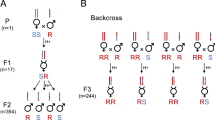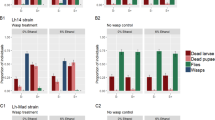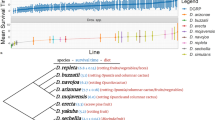Abstract
The extent to which an organism is selected to invest in defences against pathogens and parasites depends on the advantages that ensue should infection occur, but also on the costs of maintaining defences in the absence of infection. The presence of heritable variation in resistance suggests that costs exist, but we know very little about the nature or magnitude of these costs in natural populations of animals1. A powerful technique for identifying trade-offs between fitness components is the study of correlated responses to artificial selection2,3. We have selected Drosophila melanogaster for improved resistance against an endoparasitoid, Asobara tabida. Endoparasitoids are insects whose larvae develop internally within the body of other insects, eventually killing them, although their hosts can sometimes survive attack by mounting a cellular immune response4,5,6. We found that reduced larval competitive ability in unparasitized D. melanogaster is a correlated response to artificial selection for improved resistance against A. tabida. The strength of selection for competitive ability and parasitoid resistance is likely to vary temporally and spatially, which may explain the observed heritable variation in resistance.
This is a preview of subscription content, access via your institution
Access options
Subscribe to this journal
Receive 51 print issues and online access
$199.00 per year
only $3.90 per issue
Buy this article
- Purchase on Springer Link
- Instant access to full article PDF
Prices may be subject to local taxes which are calculated during checkout


Similar content being viewed by others
References
Read, A. F. et al.in Ecology of Infectious Diseases in Natural Populations(eds Grenfell, B. T.&Dobson, A. P.) 450–477 (Cambridge Univ. Press, (1995).
Partridge, L. & Fowler, K. Direct and correlated responses to selection on age at reproduction in Drosophila melanogaster. Evolution 46, 76–91 (1992).
Rose, M. R. Laboratory evolution of postponed senescence in Drosophila melanogaster. Evolution 38, 1004–1010 (1984).
Salt, G. The Cellular Defence Reactions of Insects(Cambridge Univ. Press, (1970).
Gupta, A. P. in Comprehensive Insect Physiology, Biochemistry and Pharmocology, Vol. 3(eds Kerkut, G. A. & Gilbert, L. I.) 401–451 (Pergamon, Oxford, (1985).
Strand, M. R. & Pech, L. L. Immunological basis for compatibility in parasitoid-host relationships. Annu. Rev. Entomol. 40, 31–56 (1995).
Godfray, H. C. J. Parasitoids, Behavioral and Evolutionary Ecology, (Princeton Univ. Press, NJ, (1994).
Carton, Y. & Bouletreau, M. Encapsulation ability of Drosophila melanogaster: a genetic analysis. Dev. Comp. Immunol. 9, 211–219 (1985).
Carton, Y. & Nappi, A. J. The Drosophila immune reaction and the parasitoid capacity to evade it: genetic and coevolutionary aspects. Acta Oecol. 12, 89–104 (1991).
Henter, H. J. & Via, S. The potential for coevolution in a host-parasitoid system. 1. Genetic variation within an aphid population in susceptibility to a parasitic wasp. Evolution 49, 427–438 (1995).
Hughes, K. & Sokolowski, M. B. Natural selection in the laboratory for a change in resistance by Drosophila melanogaster to the parasitoid wasp Asobara tabida. J. Insect Behav. 9, 477–491 (1996).
Kraaijeveld, A. R. & van der Wel, N. N. Geographic variation in reproductive success of the parasitoid Asobara tabida in larvae of several Drosophila species. Ecol. Entomol. 19, 221–229 (1994).
Kraaijeveld, A. R. & van Alphen, J. J. M. Geographical variation in encapsulation ability of Drosophila melanogaster larvae and evidence for parasitoid-specific components. Evol. Ecol. 9, 10–17 (1995).
Lewonton, R. C. The effects of population density and composition on viability in Drosophila melanogaster. Evolution 9, 27–41 (1955).
Santos, M., Fowler, K. & Partridge, L. On the use of tester stocks to predict the competitive ability of genotypes. Heredity 69, 489–495 (1992).
Atkinson, W. D. Afield investigation of larval competition in domestic Drosophila. J. Anim. Ecol. 48, 91–102 (1979).
McCullagh, P. & Nelder, J. A. Generalized Linear Models 2nd edn (Chapman & Hall, London, (1989).
Acknowledgements
We thank J. van Alphen, G. Boskamp, A. Burt, D. Ebert, J. Ellers, M. Fellowes, A. James, A. Leroi, J. McCabe, A. Orr, L. Partridge, A. Read, M. Rees and J. Werren for help and advice.
Author information
Authors and Affiliations
Corresponding author
Rights and permissions
About this article
Cite this article
Kraaijeveld, A., Godfray, H. Trade-off between parasitoid resistance and larval competitive ability in Drosophila melanogaster. Nature 389, 278–280 (1997). https://doi.org/10.1038/38483
Received:
Accepted:
Issue Date:
DOI: https://doi.org/10.1038/38483
This article is cited by
-
Microbiota-mediated competition between Drosophila species
Microbiome (2023)
-
A paradox of parasite resistance: disease-driven trophic cascades increase the cost of resistance, selecting for lower resistance with parasites than without them
Evolutionary Ecology (2023)
-
Can breeders prevent pathogen adaptation when selecting for increased resistance to infectious diseases?
Genetics Selection Evolution (2022)
-
Experimental immune challenges reduce the quality of male antennae and female pheromone output
Scientific Reports (2022)
-
The double-edged sword of inducible defences: costs and benefits of maladaptive switching from the individual to the community level
Scientific Reports (2022)
Comments
By submitting a comment you agree to abide by our Terms and Community Guidelines. If you find something abusive or that does not comply with our terms or guidelines please flag it as inappropriate.



